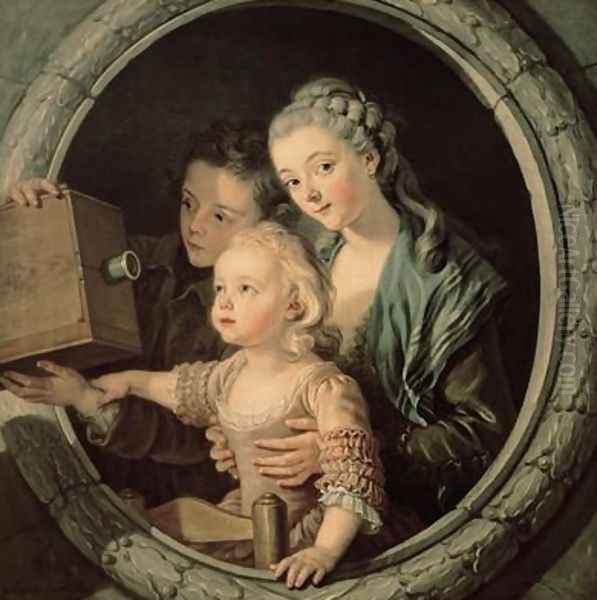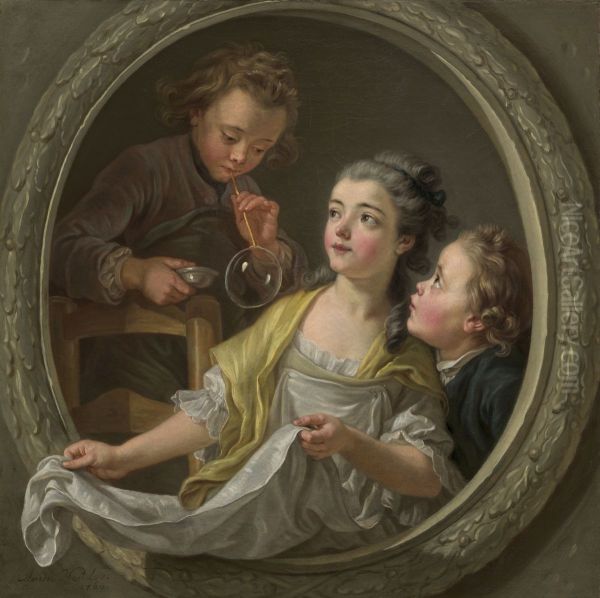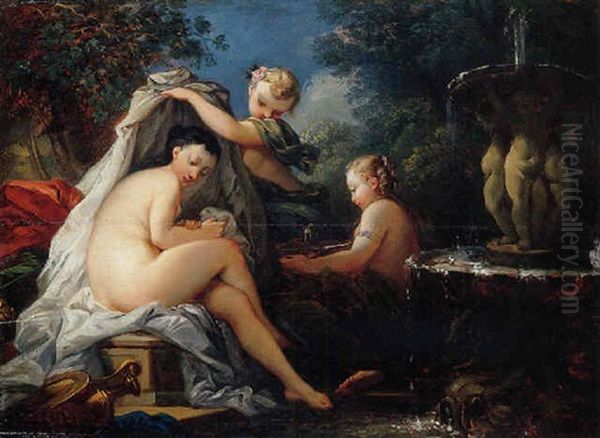Charles-Amédée-Philippe van Loo, a name perhaps less instantly recognizable than some of his contemporaries like François Boucher or Jean-Honoré Fragonard, nonetheless carved out a significant career as a painter during the zenith of the Rococo period. Born into an illustrious dynasty of artists, he skillfully navigated the aristocratic and royal courts of Europe, leaving behind a body of work that reflects the elegance, charm, and intellectual currents of the 18th century. His life and art offer a fascinating window into the interconnected world of European art, patronage, and dynastic artistic traditions.
Scion of an Artistic Dynasty: Early Life and Influences
Charles-Amédée-Philippe van Loo, often referred to simply as Amédée van Loo, was born on August 25, 1719, in Rivoli, near Turin, in the Kingdom of Sardinia (now Italy). His birth into the Van Loo family was, in itself, a profound artistic inheritance. The Van Loos were a prolific and highly successful dynasty of painters of Flemish origin who had established themselves prominently in France. His father was the esteemed Jean-Baptiste van Loo (1684–1745), a successful portraitist and historical painter who worked for prominent patrons across Europe, including the Duke of Savoy and the Prince of Carignan, and later in England and France.
Amédée's early artistic education naturally began under the tutelage of his father, alongside his brothers Louis-Michel van Loo (1707–1771), who would become First Painter to King Louis XV of France and later to the Spanish court, and François van Loo (1708–1732), whose promising career was cut short. The family environment was undoubtedly one steeped in artistic practice, discussion, and ambition. Jean-Baptiste instilled in his sons the technical rigour and versatile approach that characterized the family's output.

To further hone his skills, Amédée, following a path common for aspiring artists of his time, traveled to Italy. This journey was crucial for any artist wishing to absorb the lessons of the Old Masters and antiquity. In Rome, he studied with figures such as the painter Benedetto Luti (1666–1724), though Luti would have passed away when Amédée was very young, suggesting his influence might have been through his works or senior students, or perhaps Amédée studied with other masters active during his formative years in Italy. The influence of Roman High Baroque and the burgeoning Neoclassical sensibilities would have been part of his artistic environment. A significant milestone in his early career was winning the prestigious Prix de Rome in 1738. This award, granted by the French Académie Royale de Peinture et de Sculpture, provided a scholarship for promising artists to study in Rome, and winning it was a clear affirmation of his talent and potential.
His time in Italy was not confined to Rome. He is known to have traveled and worked in other artistic centers, including Turin, his birthplace, and Aix-en-Provence in Southern France, where his family had connections. These early years were instrumental in shaping his technical proficiency, his understanding of composition, and his ability to work across various genres, from portraiture to mythological and allegorical scenes, a versatility that would serve him well throughout his career. The influence of Italian art, with its grandeur, dynamic compositions, and rich color palettes, would remain a subtle undercurrent in his predominantly French Rococo style.
The Call to Prussia: Court Painter to Frederick the Great
A pivotal chapter in Charles-Amédée-Philippe van Loo's career began in 1748 when he was invited to Berlin to serve as court painter to Frederick II, King of Prussia, famously known as Frederick the Great. This was a significant honor and opportunity. Frederick was a renowned patron of the arts and sciences, an "enlightened despot" who sought to cultivate a sophisticated cultural atmosphere at his court, particularly at his beloved summer palace, Sanssouci, in Potsdam.
Amédée van Loo succeeded Antoine Pesne (1683–1757), another French painter who had long dominated the artistic scene at the Prussian court. Van Loo's arrival marked a continuation of Frederick's preference for French artists and the prevailing Rococo style. During his first period in Prussia, which lasted until 1758, Amédée was highly productive. He executed numerous portraits of the King, members of the royal family, and court dignitaries. These portraits were characterized by the Rococo penchant for elegance, refined execution, and a certain psychological acuity, capturing the likeness and status of his sitters.

Beyond portraiture, Amédée was commissioned to create decorative paintings, including allegorical and mythological scenes, for the royal palaces. These works would have adorned ceilings and wall panels, contributing to the lavish and sophisticated interiors favored by Frederick. His style during this period was perfectly attuned to the tastes of the court: light, graceful, often playful, yet always executed with a high degree of technical skill. He demonstrated an ability to handle complex compositions and to imbue his figures with a characteristic Rococo charm.
His interactions at the Prussian court would have brought him into contact with other artists, architects, musicians, and intellectuals whom Frederick had gathered around him, including figures like Voltaire (though their time in Berlin did not extensively overlap). The atmosphere was one of intellectual ferment and artistic creation. Amédée's role was not just to produce art but to contribute to the cultural prestige of the Prussian monarchy. He returned to Berlin for a second period of service from 1763 (after the Seven Years' War, which had disrupted his first stay) until 1769, though some sources suggest a later return in the 1770s and departure in the 1780s, indicating a sustained relationship with the Prussian court.
Parisian Prominence and the Académie Royale
Despite his significant commitments in Prussia, Charles-Amédée-Philippe van Loo maintained strong ties with Paris, the undisputed center of the European art world. He was received (agréé) into the prestigious Académie Royale de Peinture et de Sculpture in 1747, the same year he presented his reception piece, which was often a mythological or historical subject demonstrating his mastery. His reception piece was likely The Defeat of Porus by Alexander. Full membership as an Academician followed, allowing him to exhibit regularly at the Paris Salon.
The Salon was the most important public art exhibition in Europe at the time, and participation was crucial for an artist's reputation and commercial success. Amédée van Loo exhibited a variety of works at the Salon throughout his career, including portraits, mythological scenes, and genre paintings. His submissions were generally well-received, though, like many Rococo artists, he would later face criticism from proponents of the emerging Neoclassical style, championed by figures like Denis Diderot, who called for more moralizing and "serious" art.

In Paris, he was part of a vibrant artistic community. His uncle, Carle van Loo (1705–1765), was one of the most powerful and influential artists in France, holding positions such as Director of the Académie and Premier Peintre du Roi (First Painter to the King). Amédée would have benefited from his family's established reputation. He would have known and interacted with leading figures of the French Rococo, such as François Boucher (1703–1770), whose sensuous and decorative style dominated the era, and Jean-Honoré Fragonard (1732–1806), known for his exuberant scenes of love and leisure. Other contemporaries included portraitists like Jean-Marc Nattier (1685–1766), famous for his idealized depictions of court ladies, and Maurice Quentin de La Tour (1704–1788), a master of pastel portraiture.
While perhaps not reaching the absolute pinnacle of fame occupied by Boucher or his uncle Carle, Amédée established himself as a respected and sought-after artist. His ability to work successfully in different European capitals demonstrates his adaptability and the international appeal of his talent. He also took on pupils, contributing to the education of the next generation of artists, a common practice for established Academicians. One such student mentioned is Jean-François de La Frenière.
Artistic Style: Elegance, Versatility, and Rococo Sensibilities
Charles-Amédée-Philippe van Loo's artistic style is firmly rooted in the Rococo. This movement, which flourished in France from the early to mid-18th century, was characterized by its lightness, elegance, and emphasis on ornate decoration. It was a reaction against the formality and grandeur of the preceding Baroque era, favoring more intimate, playful, and sensuous themes.
His portraits, whether of Prussian royalty or French aristocrats, display a characteristic Rococo refinement. Sitters are often depicted with graceful poses, wearing sumptuous attire rendered with meticulous attention to the texture of fabrics like silk, satin, and lace. While aiming for a likeness, there was often an element of idealization, imbuing the subjects with an air of aristocratic poise and charm. His palette tended towards the lighter, pastel shades typical of the Rococo, though he could also employ richer colors when the subject demanded.
In his mythological and allegorical works, Amédée demonstrated a strong command of narrative and composition. These scenes, often drawn from classical mythology or allegorical traditions, were populated with graceful figures, often in dynamic or playful arrangements. Works like The Magic Lantern (c. 1764) or Soap Bubbles (c. 1764), now in the National Gallery of Art, Washington D.C., showcase his skill in genre-like allegorical scenes that were popular for their charm and subtle moralizing or philosophical undertones. The Magic Lantern, for instance, depicts a scene of intimate entertainment, with figures captivated by projected images, a nod to new forms of visual amusement and perhaps a metaphor for illusion and reality. Soap Bubbles is a charming allegory of the transience of life and beauty, a common theme in Vanitas paintings but rendered here with Rococo lightness.
He also produced religious paintings, though these are perhaps less central to his oeuvre than his portraits and secular allegories. When tackling religious subjects, he often imbued them with a Rococo sensibility, softening the drama and emphasizing a more tender or graceful interpretation. This was in line with the broader trend in 18th-century religious art, which often moved away from the intense emotionalism of the Baroque.
A particular anecdote mentions a trompe-l'oeil painting created for Princess Anna Amalia of Prussia, sister of Frederick the Great, depicting a young girl seemingly stepping out of the picture frame. This demonstrates his technical virtuosity and his willingness to engage in playful artistic illusionism, a feature appreciated in Rococo interiors. Such works catered to the period's taste for wit, surprise, and the blurring of art and reality. His style was adaptable, capable of meeting the demands of grand ducal commissions in Prussia as well as the more intimate tastes of Parisian collectors.
Notable Works and Their Characteristics
While a comprehensive catalogue raisonné might be extensive, several works stand out and help to define Charles-Amédée-Philippe van Loo's contribution:
Portraits of Frederick the Great and his Circle: These are numerous and form a significant part of his Prussian output. They are important historical documents as well as works of art, capturing the likeness of one of Europe's most influential monarchs. These portraits would have followed the conventions of royal portraiture, emphasizing majesty and authority, but filtered through a Rococo lens of elegance.
The Magic Lantern (c. 1764, National Gallery of Art, Washington D.C.): This painting is a prime example of his skill in creating charming and engaging genre-allegorical scenes. The composition is intimate, drawing the viewer into the dimly lit room where figures of various ages are engrossed by the projected images. The play of light and shadow is masterfully handled, and the expressions of the figures convey a sense of wonder and absorption. It speaks to the 18th-century fascination with new technologies and forms of entertainment.
Soap Bubbles (c. 1764, National Gallery of Art, Washington D.C.): A companion piece to The Magic Lantern, this work depicts children blowing soap bubbles, a classic allegory for the fragility and transience of life (Homo bulla – "man is a bubble"). However, Van Loo treats the subject with a characteristic Rococo lightness and charm, focusing on the innocence of childhood and the beauty of the iridescent bubbles. The figures are gracefully rendered, and the overall mood is one of gentle melancholy mixed with playful delight.
Allegorical and Mythological Ceiling and Wall Paintings (Sanssouci and other Palaces): While specific titles might be integrated into the architectural records of these palaces, these large-scale decorative works were crucial to his role as court painter. They would have featured Olympian gods and goddesses, personifications of virtues, or scenes from classical myths, all rendered with the flowing lines, pastel colors, and graceful figures typical of Rococo decorative schemes. Artists like Giovanni Battista Tiepolo (1696–1770) were masters of such large-scale illusionistic ceiling frescoes, and while Van Loo worked on a somewhat different scale and context, the demand for such decorative mythologies was high.
The Defeat of Porus by Alexander (Reception Piece for the Académie Royale, 1747): As his reception piece, this historical painting would have been intended to showcase his mastery of complex figural composition, dramatic narrative, and anatomical accuracy, all essential skills for a history painter, which was considered the highest genre in the academic hierarchy.
His works often featured a smooth, polished finish, with careful attention to detail, particularly in the rendering of fabrics and accessories. The figures, whether in portraits or narrative scenes, possess an inherent grace and poise. While he operated within the established conventions of Rococo art, his work is distinguished by its consistent quality and its successful adaptation to the demands of diverse patrons and contexts.
The Broader Artistic Context: Contemporaries and the Van Loo Legacy
Charles-Amédée-Philippe van Loo worked during a period of immense artistic richness and transition. The Rococo style, of which he was a notable practitioner, was dominant for much of his career, but the seeds of Neoclassicism were already being sown, particularly from the mid-century onwards.
His most immediate artistic context was, of course, his own family. The Van Loo dynasty was a veritable artistic force. His father, Jean-Baptiste van Loo, was a highly respected portraitist. His uncle, Carle van Loo, was arguably the most famous member of the family, a versatile artist who excelled in history painting, portraiture, and decorative work, and who held the most prestigious artistic posts in France. Amédée's elder brother, Louis-Michel van Loo, also achieved great success, particularly as a court painter in Spain, where he painted iconic portraits of the royal family. This familial network provided both support and a standard of excellence.
In France, the dominant figure of the Rococo was François Boucher. His sensuous nudes, idyllic pastoral scenes, and charming mythological compositions defined the taste of the era, heavily patronized by Madame de Pompadour, King Louis XV's influential mistress. Jean-Honoré Fragonard, a pupil of Boucher, carried the Rococo spirit into the later part of the century with his dynamic brushwork and scenes of amorous intrigue and playful abandon.
Other important French contemporaries included Jean-Marc Nattier, known for his elegant and often allegorized portraits of court ladies. Jean-Baptiste Oudry (1686–1755) was a master of animal painting and still life, as well as a tapestry designer. In a different vein, Jean-Baptiste-Siméon Chardin (1699–1779) offered a quieter, more introspective art, focusing on still lifes and genre scenes of bourgeois life, rendered with profound sensitivity and masterful technique. His work stood somewhat apart from the courtly Rococo but was highly esteemed. The pastellist Maurice Quentin de La Tour captured the personalities of Enlightenment figures with astonishing vivacity.
In Italy, where Amédée trained, artists like Pompeo Batoni (1708–1787) in Rome were renowned for their portraits, especially of Grand Tourists, and their refined mythological and allegorical paintings, which increasingly showed Neoclassical tendencies. In Venice, Giovanni Battista Tiepolo was the undisputed master of large-scale decorative fresco painting, his luminous and airy compositions gracing palaces and churches across Europe. Canaletto (Giovanni Antonio Canal) and Francesco Guardi captured the vedute, or cityscapes, of Venice with remarkable skill.
At the Prussian court, Amédée van Loo succeeded Antoine Pesne, who had established a French Rococo style there. The artistic environment in Berlin under Frederick the Great was cosmopolitan, and Amédée's French training and style were highly valued.
Later Years and Art Historical Assessment
Charles-Amédée-Philippe van Loo continued to paint and exhibit into his later years. He died in Paris on November 15, 1795, during the tumultuous period of the French Revolution. By this time, the Rococo style had long been superseded by Neoclassicism, championed by artists like Jacques-Louis David (1748–1825). The Revolution brought about profound changes in French society and art patronage, sweeping away much of the aristocratic world that had nurtured the Rococo.
In art historical assessment, Charles-Amédée-Philippe van Loo is recognized as a skilled and versatile painter who made significant contributions to Rococo art, particularly in France and Prussia. While perhaps not possessing the groundbreaking originality of a Watteau or the sheer decorative exuberance of a Boucher, he was a highly accomplished artist who consistently produced work of quality and elegance. His career exemplifies the international mobility of artists in the 18th century and the importance of court patronage.
Some critics, particularly those writing from a Neoclassical or later perspective, occasionally dismissed Rococo art, including works by artists like Van Loo, as frivolous or superficial. Diderot, for instance, in his Salon reviews, often criticized what he saw as the artificiality and lack of moral seriousness in some Rococo painting. However, 20th and 21st-century art history has taken a more nuanced view, recognizing the Rococo's aesthetic merits, its reflection of its era's social and cultural values, and its technical brilliance.
Charles-Amédée-Philippe van Loo's legacy lies in his refined portraits, his charming allegorical and genre scenes, and his role within the broader Van Loo artistic dynasty. His works are held in major museums, including the Louvre in Paris, the National Gallery of Art in Washington D.C., and various German collections, particularly those associated with the Prussian royal palaces. He remains an important figure for understanding the dissemination of the Rococo style and the artistic culture of 18th-century Europe. His ability to adapt his talents to the tastes of different courts and patrons, while maintaining a distinct personal style rooted in the Van Loo family tradition, speaks to his professionalism and artistic intelligence. He was a master of his craft, a painter who skillfully captured the grace, elegance, and intellectual currents of the Age of Enlightenment.